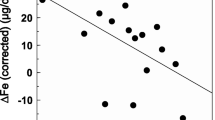Abstract
We investigated the iron-related haematological parameters in both male and female athletes participating in different sporting disciplines necessitating different metabolic energy demands. A total of 873 athletes (514 males, mean age: 22.08 ± 4.95 years and 359 females, mean age: 21.38 ± 3.88 years) were divided according to gender and to the predominant energy system required for participation in sport (aerobic, anaerobic or mixed) and haematological and iron-related parameters were measured. For both male and female athletes, significant differences related to the predominant energy system were found at a general level: male (Wilks’ λ = 0.798, F = 3.047, p < 0.001) and female (Wilks’ λ = 0.762, F = 2.591, p < 0.001). According to the ferritin cutoff value of 35 μg/L, whole body iron and sTfR significantly differed in all three groups of male and female athletes (p < 0.001). The percentage of hypochromic erythrocytes in male athletes was significantly higher only in those who required an anaerobic energy source (p < 0.001), whilst in the females hypochromic erythrocytes (p < 0.001) and haemoglobin (anaerobic, p = 0.042; mixed, p = 0.006) were significantly different only in anaerobic and mixed energy source athletes. According to the ferritin cutoff value of 22 μg/L, in females, whole body iron, sTfR and hypochromic erythrocytes were significantly higher in all three groups of athletes than those below the aforementioned cutoff value (p < 0.001). We conclude that the predominant energy system required for participation in sport affects haematological parameters. sTfR and body iron proved to be reliable parameters for monitoring the dynamics of iron metabolism and could contribute to successful iron-deficiency prevention.



Similar content being viewed by others
References
Astrand PO, Rodahl K, Dahl H, Stromme S (2003) Textbook of work physiology, 4th edn, Human kinetics, Champaign
Banfi G, Del Fabbro M (2007) Behaviour of reticulocyte counts and immature reticulocyte fraction during a competitive season in elite athletes of four different sports. Int J Lab Hematol 29:127–131
Banfi G, Dolci A (2003) Preanalytical phase of sport biochemistry and hematology. J Sports Med Phys Fitness 43:223–230
Banfi G, Mauri C, Morelli B, Di Gaetano N, Malgeri U, Melegati G (2006) Reticulocyte count, mean reticulocyte volume, immature reticulocyte fraction, and mean sphered cell volume in elite athletes: reference values and comparison with the general population. Clin Chem Lab Med 44:616–622
Banfi G, Lombardi G, Colombini A, Lippi G (2010) A world apart: inaccuracies of laboratory methodologies in antidoping testing. Clin Chim Acta 411:1003–1008
Chatard JC, Mujika I, Guy C, Lacour JR (1999) Anaemia and iron deficiency in athletes. Practical recommendations for treatment. Sports Med 27:229–240
Cook JD (1999) Defining optimal body iron. Proc Nutr Soc 58:489–495
Cook JD, Flowers CH, Skikne BS (2003) The quantitative assessment of body iron. Blood 101:3359–3363
Di Santolo M, Stel G, Banfi G, Gonano F, Cauci S (2008) Anemia and iron status in young fertile non-professional female athletes. Eur J Appl Physiol 102:703–709
Dopsaj V, Sumarac Z, Novakovic N, Dopsaj M (2008) Determination of parameters of iron status in evaluation of anemia in elite young Serbian water polo players. Serb J Sports Sci 2:91–100
Dubnov G, Constantini NW (2004) Prevalence of iron depletion and anemia in top-level basketball players. Int J Sport Nutr Exerc Metab 14:30–37
Fallon KE (2008) Screening for haematological and iron-related abnormalities in elite athletes-analysis of 576 cases. J Sci Med Sport 11:329–336
Landahl G, Adolfsson P, Borjesson M, Mannheimer C, Rodjer S (2005) Iron deficiency and anemia: a common problem in female elite soccer players. Int J Sport Nutr Exerc Metab 15:689–694
Malczewska J, Blach W, Stupnicki R (2000) The effects of physical exercise on the concentrations of ferritin and transferrin receptor in plasma of female judoists. Int J Sports Med 21:175–179
Nielsen P, Nachtigall D (1998) Iron supplementation in athletes. Sports Med 26:207–216
Pedersen BK, Steensberg A, Schjerling P (2001) Exercise and interleukin-6. Curr Opin Hematol 8:137–141
Peeling P, Blee T, Goodman C, Dawson B, Claydon G, Beilby J, Prins A (2007) Effect of iron injections on aerobic exercise performance of iron depleted female athletes. Int J Sport Nutr Ex Metab 17:221–231
Powers S and Howley E (2006) Bioenergetics. In: Exercise physiology: theory and application to fitness and performance, 7th edn. McGraw-Hili Companies, New York, pp 45–48
Roecker L, Meier-Buttermilch R, Brechtel L, Nemeth E, Ganz T (2005) Iron-regulatory protein hepcidin is increased in female athletes after a marathon. Eur J Appl Physiol 95:569–571
Schumacher YO, Grathwohl D, Barturen JM, Wollenweber M, Heinrich L, Schmid A, Huber G, Keul J (2000) Haemoglobin, haematocrit and red blood cell indices in elite cyclists: are the control values for blood testing valid? Int J Sports Med 21:380–385
Schumacher YO, Schmid A, Grathwohl D, Bültermann D, Berg A (2002) Hematological indices and iron status in athletes of various sports and performances. Med Sci Sports Exerc 34:869–875
Shaskey DJ, Green GA (2000) Sports Haematology. Sports Med 29:27–38
Suominen P, Punnonen K, Rajamaki A, Irjala K (1998) Serum transferin receptor and transferin receptor-ferritin index identify healthy subjects with subclinical iron deficiency. Blood 92:2934–2939
Thomas C, Thomas L (2002) Biochemical markers and hematologic indices in the diagnosis of functional iron deficiency. Clin Chem 48:1066–1076
Conflicts of interest
The authors declare that they have no conflicts of interest.
Author information
Authors and Affiliations
Corresponding author
Additional information
Communicated by Susan Ward.
Rights and permissions
About this article
Cite this article
Milic, R., Martinovic, J., Dopsaj, M. et al. Haematological and iron-related parameters in male and female athletes according to different metabolic energy demands. Eur J Appl Physiol 111, 449–458 (2011). https://doi.org/10.1007/s00421-010-1656-7
Accepted:
Published:
Issue Date:
DOI: https://doi.org/10.1007/s00421-010-1656-7



